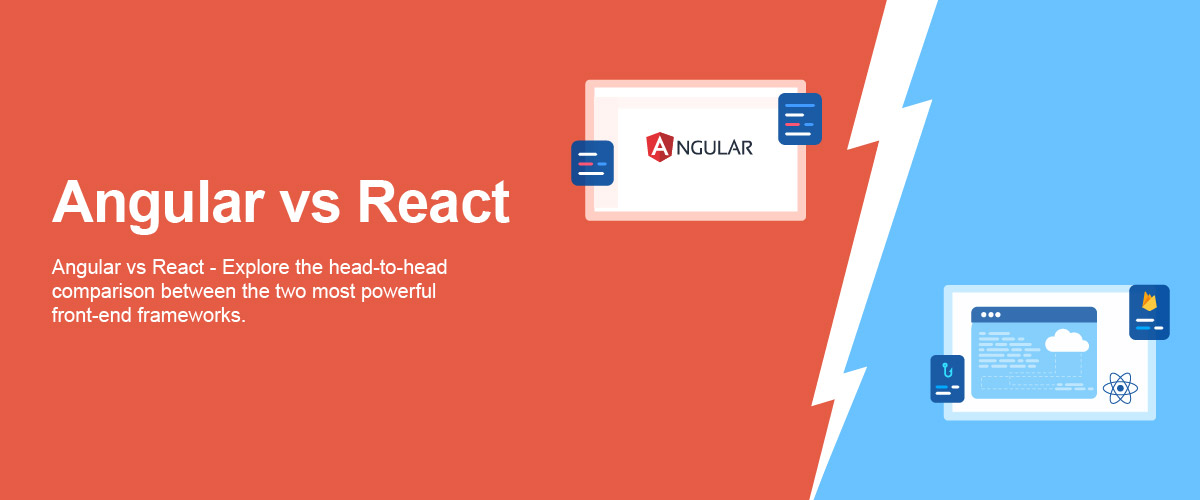Angular Vs React: Difference Between Angular And React
Are you struggling to decide which JavaScript framework to choose for your next project? According to a 2022 survey by Stack Overflow, React, and Angular have become the go-to technologies for developers, holding a market share of 44.31% and 23.06% respectively.
React, an open-source JavaScript library, was introduced by Facebook in 2013 and quickly gained traction among developers for its declarative, component-based approach to building user interfaces. Angular, on the other hand, is a full-fledged JavaScript framework developed by Google in 2010, widely acclaimed for its two-way data binding and dependency injection capabilities.
This blog aims to provide an in-depth comparison of Angular vs React, equipping you with the knowledge you need to make an informed decision, and weighing the pros and cons of each framework to help you identify the perfect match for your upcoming venture.
What are Angular and React?
The two most prominent front-end JavaScript frameworks used to construct contemporary web apps are Angular and React. Angular is a comprehensive framework developed by Google for building dynamic, client-side web applications. To overcome development issues, the framework is developed in TypeScript and includes declarative templates, dependency injection, end-to-end tools, and integrated best practices. It offers a collection of tools and capabilities for developing large-scale, complicated systems, with a strong emphasis on modularity, dependency injection, and two-way data binding. React, on the other hand, is a Facebook-developed library that focuses on creating reusable user interface components. It enables developers to create sophisticated user interfaces through the use of declarative syntax and a component-based design.
Both Angular or React have advantages and disadvantages, and which one is best for a given project is determined by a variety of criteria such as project needs, team expertise, and development objectives.
Angular encourages the use of a component-based architecture, which simplifies the process of creating and maintaining web applications by breaking them down into smaller, modular components. Angular also has robust testing tools, including end-to-end testing, which can help teams ensure their application is working correctly. React, on the other hand, has a more lightweight and flexible approach. It has a virtual DOM, which provides improved performance by updating only the parts of the UI that have changed, rather than re-rendering the entire page.
Also Read: React Developer Tools
Difference Between Angular and React
Here’s a table that summarizes the key features and differences between Angular and React:
| Feature | Angular | React |
|---|---|---|
| Purpose | Full-featured framework with strong opinions on app design | UI-focused library, more flexibility in code organization |
| Data Binding | Supports both one-way and two-way data binding | One-way data binding |
| Language | TypeScript, a superset of JavaScript | JavaScript with optional JSX support |
| UI Components | Material Design Components | Material-UI Library & Dependencies |
| Dependency Injection | Built-in support for dependency injection | No full support for dependency injection |
| DOM | Incremental DOM | Virtual DOM |
| Component Architecture | Rich, feature-packed component architecture | Straightforward, adaptable component-based structure |
| Performance | Can have performance issues due to two-way data binding | Faster rendering using virtual DOM |
| Reactive Programming | Built-in support for reactive programming | Offers Reactive programming via third-party libraries |
| Error Handling | Robust error-handling features | Less comprehensive error handling |
| Modular Architecture | Breaks applications into small, manageable modules | Breaks applications into smaller, reusable components |
| Server-Side Rendering | Server-side rendering is available but requires extra effort | Better server-side rendering support |
| Community and Ecosystem | Comprehensive framework, standardized development process | Larger developer community, extensive ecosystem |
| Mobile-Friendly | Mobile-first approach | Mobile support via React Native |
| Learning Curve | Steeper learning curve due to complex architecture | Faster learning curve due to simplicity |
| Security | High-security standards, built-in security features | Security implemented via third-party libraries |


Angular Vs React: Which is Better?
Both Angular or React have their distinct utilities, making them suitable for specific use cases. Here are some utilities and use cases of both Angular and React, to help you understand their applications and decide which one is more suitable for your next project.
React
- Front-End Web Applications: React excels in developing fast and scalable front-end web applications. With its component-based architecture and virtual DOM, React ensures optimized performance and easy maintainability.
- Mobile Applications: React Native has gained popularity as a framework grounded in React, enabling the creation of native mobile apps for both iOS and Android. Its smooth performance, user-friendly elements, and reusable code for web and mobile applications are key benefits.
- E-Commerce Websites: React’s efficient performance and easy-to-manage structure make it well-suited for building e-commerce websites. Its modular components facilitate the design of responsive and engaging interfaces that enhance user experience.
- Social Media Platforms: Thanks to React’s strong performance and capability to manage numerous components, it is an ideal option for social media platforms with a high volume of user interactions, media sharing, and live updates.
- Gaming Platforms: React is useful for creating interactive gaming platforms featuring high-quality user interfaces. The library’s versatility and compatibility with various game engines make it a top choice for web-based gaming platforms.
If you think the React framework is the framework for you, and you’d like to learn extensively on this, you could take this React course to gain better knowledge.
Also Read: React Projects Ideas
Angular
- Large Enterprise Applications: Angular is a robust framework built to handle complex and large-scale enterprise applications. With its dependency injection, modular architecture, and comprehensive toolset, Angular simplifies the development, testing, and maintenance of enterprise applications.
- Single Page Applications (SPAs): Angular is designed for building highly-responsive SPAs that load a single HTML page and dynamically update the content as the user interacts with the application. Angular’s built-in features like routing and lazy loading make it easy to create efficient SPAs.
- Interactive Dashboards: Angular’s two-way data binding, component-based architecture, and directives allow developers to create dynamic and interactive dashboards for data visualization and real-time monitoring.
- Real-Time Applications: Angular’s support for WebSockets, Observables, and real-time data synchronization makes it suitable for building real-time applications like chat applications, online collaboration tools, and live analytics.
- Progressive Web Applications (PWAs): Angular’s built-in support for service workers, application shell, and offline capabilities make it an ideal choice for developing PWAs, which are web applications that deliver a native app-like experience to users.
If you think the Angular framework works best for you, then you should take a look at this Angular course.
React Vs Angular: When to Choose What?
When choosing between React vs Angular, it’s important to consider the project requirements, development team experience, and other factors that may affect the development process.
React:
With React JS, the main focus is on creating reusable UI components and providing a simple and efficient way to manage the application state.
- Small to Medium-Sized Projects: React JS is perfect for projects on a smaller or moderate scale due to its straightforward nature, adaptability, and light structure.
- Faster Rendering and Server-Side Rendering Capabilities: React JS employs a virtual DOM to update the user interface effectively, resulting in better performance and rapid rendering. This attribute is especially valuable for single-page apps (SPAs) and server-side rendering.
- Easy to Learn and Use: React JS has a relatively simple learning curve, making it more accessible for developers new to JavaScript frameworks. It enables an easy transition from basic JavaScript to a structured framework.
Angular
Angular provides a powerful set of tools and libraries, making it ideal for large, intricate projects.
- Large, Complex Web Applications: Angular is designed to manage complex projects with a wide range of features and numerous components. It offers a structured approach to development, which can be advantageous for handling extensive codebases.
- Stronger Type System and Error-Handling Capabilities: Angular uses TypeScript, a statically-typed superset of JavaScript, which provides better type-checking, autocompletion, and error handling during development.
- Mobile-First Approach and Better Support for Progressive Web Applications (PWAs): Angular provides native support for building PWAs, which are web applications that can be installed on mobile devices, offering a native-like user experience.
Get a confirmed ₹35,000 total stipend after your placement! Enroll in our Full stack developer placement Guarantee course.
Decision Criteria for Choosing Between Angular Or React
Before making a choice between the two, here are some criteria that might help you make better decisions. You should consider:
- Project Requirements and Scope: Evaluate the project’s complexity and functionality requirements to determine if a lightweight library like React or a comprehensive framework like Angular would be more appropriate.
- Developer Skills and Experience: Consider the development team’s familiarity with each framework and their ability to quickly ramp up and become productive.
- Time and Budget Constraints: Smaller projects with tight deadlines and limited budgets may benefit from the simplicity and speed of React, whereas larger projects with more resources might be better suited for Angular’s comprehensive toolset.
- Integration with Other Technologies: If your project requires integration with other technologies or third-party libraries, consider how well each framework supports those integrations.
There is no one-size-fits-all answer to whether React or Angular is the best choice for your project. By carefully evaluating your project requirements, developer experience, and other factors, you can make an informed decision that best suits your project’s needs.
Conclusion
The choice between Angular vs React depends on a variety of factors but both frameworks have their unique advantages and cater to different use cases. When choosing between React and Angular, it’s crucial to consider your project’s unique requirements, your development team’s familiarity with the frameworks, and the resources you have at your disposal. Through thorough evaluation, you can make an informed decision on the ideal framework to aid in the success of your forthcoming endeavor.







